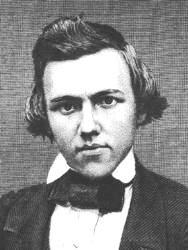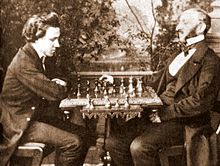
- Chess World Cup
- FIDE Grand Prix
- Olympiad
- World Championship
- List of strong tournaments
- List of world championships

- Checkmate patterns
- Chess openings
- Chess strategy
- Chess tactics
- Chess theory
- Endgames
- Pawn structure
- Problems/Compositions












 Paul Morphy
Paul MorphyThe Morphy number is a measure of how closely a chess player is connected to Paul Morphy (1837-1884) by way of playing chess games. People who played a chess game with Morphy have a Morphy number of 1. Players who did not play Morphy but played someone with a Morphy number of 1 have a Morphy number of 2. People who played someone with a Morphy number of 2 have a Morphy number of 3, et cetera.
The idea is similar to the Erdős number for mathematicians and the Bacon number for actors. For example, Viswanathan Anand, along with many current top players, has a Morphy number of 5: Anand played Efim Geller (Morphy number 4), who played Salo Flohr (Morphy number 3), who played Géza Maróczy (Morphy number 2), who played John Owen (Morphy number 1), who played Morphy. Taylor Kingston states that the idea of the Morphy number may have originated in a June 2000 note by Tim Krabbé, who has Morphy number 4.
 Morphy and Löwenthal, who is getting a Morphy number of 1
Morphy and Löwenthal, who is getting a Morphy number of 1As of 2015, Leonard Barden, Pal Benko, Arthur Bisguier, Melvin Chernev, Dennis Horne, Borislav Ivkov, Erik Karklins, Franciscus Kuijpers, Aleksandar Matanović, Friðrik Ólafsson, Jonathan Penrose, Oliver Penrose, Arturo Pomar, and Peter Swinnerton-Dyer are the only known living players with Morphy number 3.
Many ordinary players have a Morphy number of 6 or less.
These are players who are important in making links for Morphy numbers.
Morphy is known to have played about 100 people, but all of the known links for players with Morphy number 2 go through the following six players. Some Irish players could go through the Rev. Dr George Salmon, who played in one of Morphy's blindfold chess simultaneous exhibitions.
Everyone in this group played someone in the group above. Some of the most important members of this group follow. Tartakower lost to Mortimer early in his chess career, which spanned beyond WW2, so allowed many younger players to gain a 3.
Most of the masters in this group played several members of the previous group. This group includes some of the most important players for making connections to later generations. Botvinnik and Reshevsky played older masters such as Lasker and Janowski, had long careers, and played many younger players. Najdorf was Tartakower's pupil and they played a number of published games together, and Najdorf played blitz right into his 80s, allowing many younger players to achieve 4. C.J.S. Purdy played Tartakower (2), enabling many Australian players to achieve 4. As of March 2015, fewer than 15 of them are still alive.
As of 2013 many of these players are still alive; a few (such as Short) are still active.
As of 2013 many of the top grandmasters are in this group (along with a large number of lesser players).